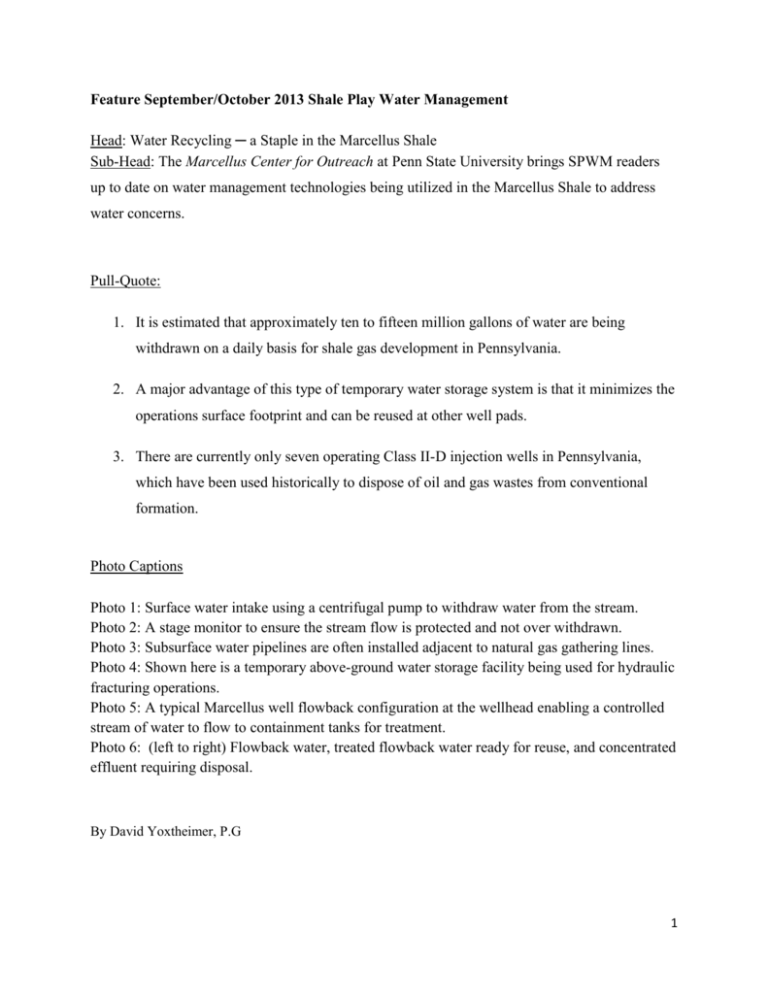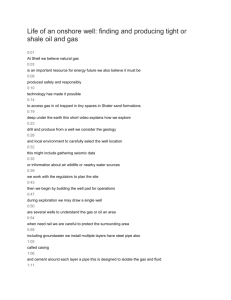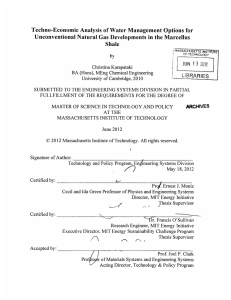Marcellus-Regional-Update-1.5FINAL
advertisement

Feature September/October 2013 Shale Play Water Management Head: Water Recycling ─ a Staple in the Marcellus Shale Sub-Head: The Marcellus Center for Outreach at Penn State University brings SPWM readers up to date on water management technologies being utilized in the Marcellus Shale to address water concerns. Pull-Quote: 1. It is estimated that approximately ten to fifteen million gallons of water are being withdrawn on a daily basis for shale gas development in Pennsylvania. 2. A major advantage of this type of temporary water storage system is that it minimizes the operations surface footprint and can be reused at other well pads. 3. There are currently only seven operating Class II-D injection wells in Pennsylvania, which have been used historically to dispose of oil and gas wastes from conventional formation. Photo Captions Photo 1: Surface water intake using a centrifugal pump to withdraw water from the stream. Photo 2: A stage monitor to ensure the stream flow is protected and not over withdrawn. Photo 3: Subsurface water pipelines are often installed adjacent to natural gas gathering lines. Photo 4: Shown here is a temporary above-ground water storage facility being used for hydraulic fracturing operations. Photo 5: A typical Marcellus well flowback configuration at the wellhead enabling a controlled stream of water to flow to containment tanks for treatment. Photo 6: (left to right) Flowback water, treated flowback water ready for reuse, and concentrated effluent requiring disposal. By David Yoxtheimer, P.G 1 Introduction The Marcellus Shale is estimated to be North America’s largest natural gas reservoir with recoverable reserves calculated at nearly 500 trillion cubic feet, a volume that at current rates of use would meet the U.S. demand for natural gas for about 20 years. Development of the Marcellus Shale is occurring at a rapid pace, especially in Pennsylvania where more than 7,000 wells have been drilled through July 2013 and with more than 4,000 producing wells, each of which has been hydraulically fractured. Shale gas formation, like the Marcellus, are very promising as an abundant domestic energy source, but their development faces environmental challenges including proper water resources management. This article examines some of the water management technologies being utilized in the Marcellus Shale to address water concerns. Water Sourcing The volume of fluid used to hydraulically fracture a Marcellus horizontal well is typically four to five million gallons, which is necessary to open fractures in the low permeability shale. Water used in the hydraulic fracturing process is withdrawn from sources that are approved by the Pennsylvania Department of Environmental Protection (PaDEP) prior to use and may also require approval from river basin commissions, such as the Susquehanna River Commission. These sources of water may include surface water intakes on streams or rivers, groundwater supply wells, water purchased from public water suppliers, abandoned mine discharges, treated municipal wastewater, or other alternative sources. Based on the typical volume of water used for hydraulic fracturing and the number of wells brought into production based on public records, it is estimated that approximately ten to fifteen million gallons of water are being withdrawn on a daily basis for shale gas development in Pennsylvania. Photos 1 and 2 show an intake in a river and a stream stage monitor to ensure that adequate flow remains in the stream. The stream withdrawal point must have a screened inlet that minimizes the entrance velocity of water to avoid entrainment or impingement of aquatic species. Water is transported to the well site either via tanker trucks or piped where pipelines exist. Subsurface water pipelines are often being installed along with natural gas gathering lines as shown in Photo 3. Use of pipelines for water transfer minimizes trucking along with road 2 damage, and diesel fuel use and can be approximately 50 percent less expensive than trucking, and is, therefore, a preferred practice. Water is often stored in earthen impoundments with an impermeable liner designed to meet regulatory standards to prevent failure. More recently operators have moved toward use of temporary above-ground storage facilities, as shown in Photo 4, which can be erected within a few days, removed and reused at another site. A major advantage of this type of temporary water storage system is that it minimizes the operations surface footprint and can be reused at other well pads. Produced Water Management Once a hydraulic fracturing process has been completed, approximately 10 percent of injected fluids may flow out of the well initially as it cleans up over the course of several days or weeks prior to being put into production. This initial return of water is generally known as flowback water and typically has elevated concentrations of total dissolved solids (TDS) which may include salts, metals, volatile organic compounds, radionuclides, and residual fracturing fluid additives. Most of the fluids remain bound in the shale formation and will slowly flow out of the well as produced water along with natural gas at a rate of several barrels per million cubic feet of gas produced, and the volume generally decreases with time. Collectively, the flowback and produced fluids must be properly contained and treated due to the high levels of TDS that would be considered toxic to freshwater species or could adversely impact soil and/or water quality if released to the environment. Photo 5 shows a typical Marcellus well flowback configuration installed at the wellhead, allowing a controlled stream of the flowback water to flow into frac tanks for containment. Photo 6 features examples of flowback and treated effluent. In response to the Marcellus Shale industry’s anticipated growth and associated increase in produced fluid volumes in Pennsylvania, PaDEP updated its Chapter 95 regulations in August 2010, establishing new treatment standards for facilities that receive, treat and discharge high TDS produced fluids. Any facility having an influent TDS concentration greater than 2,000 mg/L now needs to meet the following effluent discharge standards: TDS < 500 mg/L; Cl < 250 mg/L; Sr < 10 mg/L; Ba < 10 mg/L, thus typically requiring desalination to meet these standards. 3 Various treatment approaches can be used to remove salts from produced fluids depending on TDS concentration. Chemical precipitation followed by clarification is capable of removing metals such as barium, strontium, iron, and calcium, but is not effective at salt removal; therefore it is often used as pre-treatment in association with desalination or as a stand-alone treatment for reuse in hydraulic fracturing. Moderate TDS levels (<50,000 mg/L) can be removed with membrane filtration processes, such as reverse osmosis, while high TDS produced fluids must be treated using more energy-intense, costly methods such as thermal distillation. Reuse in subsequent hydraulic fracturing operations or for enhanced oil recovery, is an alternative option for management of produced fluids. Reuse often entails some form of pretreatment, such as described above; however, since the treated fluid is not discharged, effluent TDS concentrations do not need to be as low. Over the last few years there has been a shift to reuse more produced fluids in Marcellus well fracturing operations in Pennsylvania, as well as in other shale plays around the U.S. Reuse of water can be cost competitive when compared to alternatives such as treatment and discharge or disposal well injection, as it reduces the need to purchase or source fresh water. The ability to reuse treated produced fluid is due in part to the recent development of fracturing mixtures that are brine tolerant. Based on review and analysis of PaDEP records for 2012 the reuse rate of flowback and produced fluids was approximately 87 percent, where 23.2 million barrels of fluids were reused out of 26.8 million barrels generated. Approximately 85 percent of the recycling occurred in the field with the remaining 15 percent treated at centralized treatment facilities. The remaining 13 percent of fluids were disposed of via Class II-D disposal wells, which may occur for a number of reasons, including higher treatment costs or inability to reuse the water due to a lack of scheduled fracturing operations in the near term. In the Appalachian Basin there are a limited number of Class II-D injection wells, due in part to the lack of suitable injection reservoirs with sufficient depth and permeability to accept significant volumes of waste. There are currently only seven operating Class II-D injection wells in Pennsylvania, which have been used historically to dispose of oil and gas wastes from conventional formation oil and gas wells and, therefore, have limited additional capacity. In order to manage the increased volume of Marcellus produced fluids in Pennsylvania, they are being transported primarily to Ohio, where 41 wells were reported to have accepted Marcellus 4 wastewater generated in Pennsylvania. There has been a significant increase in the use of Ohio’s Class II-D wells in recent years. The volume of waste being disposed of in Ohio’s injection wells increased from about six million barrels in 2008 to more than 14 million barrels in 2012, largely as a result of the increased production of Marcellus shale gas in Pennsylvania and West Virginia. Discussion The Marcellus Shale is an enormous energy resource for the U.S. that can provide economic stimulus and energy security. With development of this cleaner burning fuel, however, environmental challenges exist. Proper management of fluids derived from drilling and hydraulic fracturing operations is necessary to ensure Pennsylvania’s water quality is not compromised. The industry has significantly improved its fluids’ management by utilizing best management practices, such lining well pads to capture spills, utilizing closed-loop drilling systems, and recycling flowback fluids. Continued improvement in fluids management practices is expected to continue as companies further refine their operations to meet environmental and regulatory challenges. It’s simple. The recycling of flowback and produced water is a major innovation for the industry because using less fresh water and reducing the need for disposal protects water resources in the Marcellus. ABOUT THE AUTHOR David Yoxtheimer, P.G. is a hydrogeologist, Extension Associate with Penn State University’s Marcellus Center for Outreach and Research and serves as a liaison between the University, natural gas industry, environmental organizations, local government and the general public to advise stakeholders on key environmental issues. He earned his B.S. in Earth Science from Penn State, where he is currently completing his Ph.D. in Geosciences. Previous to joining MCOR he spent 18 years as a consulting hydrogeologist with expertise in water supply development, karst hydrogeology, geophysical surveying, environmental permitting, shale energy geology, and integrated water resource management. 5 6






